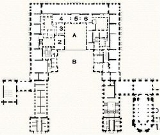
Appartement du roi
Encyclopedia
The appartement du roi is the suite of rooms in the Palace of Versailles
that served as the living quarters of Louis XIV. Overlooking the cour de marbre, these rooms are situated in the oldest part of the chateau in rooms originally designated for use by the queen in Louis XIII’s chateau. Owing largely to discomfort of the grand appartement du roi
and to the construction of the Hall of Mirrors
, Louis XIV began to remodel these rooms for his use shortly after the death of Maria Theresa
in 1684. The appartement du roi evolved to become the everyday working quarters for Louis XV and Louis XVI.
Initially, the appartement du roi consisted of a suite of eight rooms that issued from the Queen’s staircase (escalier de la reine). The number would later be reduced to seven after 1701; and in 1755 the number would reduced again to six.
, and the apartment of Madame de Maintenon
.
, "The Battle of Leuze, 18 September 1691", hung over the fireplace. Two large chandeliers emblazoned with the king’s monogram complemented the decor. The utilitarian nature of the room was evidenced by the wooden benches, camp beds, and folding screens used by the guards stationed in the room. On Mondays, a table, dressed with a gold-fringed velvet rug, would be placed in this room, at which Louis XIV would personally accept petitions presented to him by his subjects.
with the “Battle of Arbela” being displayed over the mantelpiece. After the death of the queen
and the dauphine, the room served for those occasions during which Louis XIV dined alone in public. For the grand couvert, a table with a single armchair was dressed before the fireplace. The wall opposite the fireplace originally contained a tribune for musicians, but this was suppressed in the 18th century.
The end of one the more scandalous events in Versailles history during the Sun King’s reign transpired in this room. In 1691, the fringe from the portieres in the Salon de Mars and part of the embroidered bed cover from the bed in the Salon de Mercure were stolen. Toward the service of dessert, a bundle was thrown through one of the windows facing the cour de marbre and landed on the king’s table. Louis XIV’s only comment, “I think that those are my fringes.”
, Louis XIV attached this room to his apartment.
The deuxième antichambre served as waiting room for courtiers waiting to attend the king’s lever in the chambre du roi next door. This room was also known as the antichambre des Bassans on account of the number of paintings by the northern Italian artists, Jacopo Bassano
, that were displayed on the walls. Over the mantelpiece, the famed “Noli me tangeres” by Lambert Sustris
was displayed. In 1701, the deuxième antichambre and the chambre du roi were combined to form the salon de l’œil de bœuf, which became the main antechamber to the king’s new bedroom.
Taking is name from the oval window located in the south cove of the ceiling, the salon de l’œil de bœuf features a gilt-stucco running frieze that decorated the cove of the room’s ceiling and features a trellis-work background on which are groups of dancing putti. It is the decoration of the cove that heralds a transition from the formalistic style that was used in the decoration of the grand appartement du roi
and the Hall of Mirrors
to a more relaxed style that anticipated the style Louis XV
. Louis XIV spared no expense in decorating this room. Mirrors, “The Fainting of Ester” and “Judith with the head of Holofernes” by Veronese
hung as pendants, and gilt furniture all contributed to making this one of the most sumptuous rooms in the appartement du roi.
When Louis XIV moved into the chambre du roi in 1684, the following room was designated as the salon du roi or the salon où le roi s’habille. For 17 years, this room served as venue for the ceremonies that surrounded the life of the king, such as the lever and the coucher.
was constructed. When the chambre de Louis XIV was established in 1701, the room became the ideological as well as physical focal point of the palace.
As a measure of economy, Louis XIV retained much of the decor of the salon du roi in decoration of the chambre de Louis XIV. The over-door paintings included The Portrait of Francisco de Moncada
and a Self-portrait the two by Anthony van Dyck
, Saint John the Baptist
by Caravaggio
, and Mary Magdalene
by Guido Reni
. Domenichino’s
Saint Cecilia
was placed in the cornice setting of the south wall above the fireplace and the artist’s King David
playing the harp hung as pendant opposite on the north wall.
The western wall of the room became the wall of the alcove – the area of the room separated by a balustrade in which the bed was located. The decoration of the alcove, with the ornaments of the agrafe and volutes as well as the trelliswork sculpture, anticipate in many respects anticipates the style Régence
that was in vogue between 1715-1723. Crowning the bed is Nicolas Coustou’s
relief sculpture, France Triumphant, which is complemented by two relief sculptures of Fame by François Lespingola
located in the pendentives of the arch.
The present brocade on the walls of the alcove and for the bed has been rewoven as part of the initiative of the Fifth Republic
to restore Versailles
. The original alcove and bed hangings were restored in 1736; and, in 1785, Louis XVI ordered the brocade burned from which he obtained over 60 kilograms of gold. The present hanging, while accurate for the period, are not a reproduction of the brocaded that originally hung in the chambre de Louis XIV. Owing to lack of archival information when the project was under taken, it was decided to use the pattern for hangings of the tenture d’hiver for the queen’s bedroom. Only after the project was underway were the original designs found; as the part of the project had been completed, it was decided to use the queen’s tenture d’hiver. On 1 September 1715, Louis XIV died in this room.
, which occupied site of the Salon de Jupiter, Louis’s previous council chamber. Initially called cabinet du roi from 1684, with the remodeling of the apartment that occurred in 1701, this room received a new decor that featured walls paneled with mirrors. With the redecoration, the room was rechristened cabinet des glaces. In spite of the luxury of mirrors, this room was furnished in a utilitarian manner. In addition to the velvet covered council table, there were three armchairs and 12 folding stools and a daybed, which Louis XIV used in 1686 as a necessity while suffering from an anal fistula and the surgery that removed it.
Of all the rooms of the appartement du roi, this room perhaps best expressed the personal tastes of Louis XIV. In addition to the collection of gems, there were works by Nicolas Poussin
and Giovanni Lanfranco
on the walls as well as Harpsichord
with a painted case. The personal nature of this room was offset by the fact that this was the room in which Louis XIV governed France. Councils were held here, writers who extolled the gloire of the Sun King were received here, and private audiences most often occurred in this room.
The last room of the appartement du roi was the cabinet des termes – due to the decor that featured 20 Hermes – also called the cabinet des perruques, as this was the room in which Louis XIV’s wigs were stored. In addition to the gilt Hermes that decorated the wall, the doors were covered with mirrors. The room served as a changing room for the king, where he would change his shirt, wig, and hat as many as four times a day. In the evening, this room would be where Louis XIV would gather with his children, other members of his family, and selected courtiers.
The cabinet des glaces and the cabinet des perruques disappeared in 1755 when Louis XV ordered the enlargement and redecoration of the council chamber. This is the room that is seen today.
In 1748, in order to accommodate the newly constructed cabinet du roi on the 3rd floor, Louis XV had the ceiling of the cabinet de glaces lowered by about a meter. The new dimension to the room necessitated a complete redecoration of the room. The following year, a new fireplace was installed and the one dating from the time of Louis XIV and was sent to Compiègne
. In 1755, during the installation of a terrace in the cour des cerfs, Louis XV decided to enlarge the council room by incorporating the cabinet des perruques. This larger room was designed by Ange-Jacques Gabriel
with the paneling sculpted by Jules-Antoine Rousseau. The panels were sculpted with symbols appropriate to governance: trophies of peace and war, attributes of the army, navy, justice, and the insignia of the monarchy.
Palace of Versailles
The Palace of Versailles , or simply Versailles, is a royal château in Versailles in the Île-de-France region of France. In French it is the Château de Versailles....
that served as the living quarters of Louis XIV. Overlooking the cour de marbre, these rooms are situated in the oldest part of the chateau in rooms originally designated for use by the queen in Louis XIII’s chateau. Owing largely to discomfort of the grand appartement du roi
Palace of Versailles
The Palace of Versailles , or simply Versailles, is a royal château in Versailles in the Île-de-France region of France. In French it is the Château de Versailles....
and to the construction of the Hall of Mirrors
Hall of Mirrors (Palace of Versailles)
The Hall of Mirrors is the central gallery of the Palace of Versailles and is renowned as being one of the most famous rooms in the world.As the principal and most remarkable feature of King Louis XIV of France's third building campaign of the Palace of Versailles , construction of the Hall of...
, Louis XIV began to remodel these rooms for his use shortly after the death of Maria Theresa
Maria Theresa of Spain
Maria Theresa of Austria was the daughter of Philip IV, King of Spain and Elizabeth of France. Maria Theresa was Queen of France as wife of King Louis XIV and mother of the Grand Dauphin, an ancestor of the last four Bourbon kings of France.-Early life:Born as Infanta María Teresa of Spain at the...
in 1684. The appartement du roi evolved to become the everyday working quarters for Louis XV and Louis XVI.
Initially, the appartement du roi consisted of a suite of eight rooms that issued from the Queen’s staircase (escalier de la reine). The number would later be reduced to seven after 1701; and in 1755 the number would reduced again to six.
Vestibule
The vestibule is paneled in marble and lighted by two windows that opened onto the cour royale. In 1701, in order to provide more light to the staircase, the south wall opposite the windows was opened, thus creating a loggia from the vestibule. During the latter part of Louis XIV’s reign, the Queen’s staircase and the vestibule served as entrance to the appartement du roi, the grand appartement de la reinePalace of Versailles
The Palace of Versailles , or simply Versailles, is a royal château in Versailles in the Île-de-France region of France. In French it is the Château de Versailles....
, and the apartment of Madame de Maintenon
Françoise d'Aubigné, Marquise de Maintenon
Françoise d'Aubigné, Marquise de Maintenon was the second wife of King Louis XIV of France. She was known during her first marriage as Madame Scarron, and subsequently as Madame de Maintenon...
.
Salle des gardes du roi
The salle des gardes du roi, served to house the Garde du corps du roi – the King’s Body Guard. The early decor of this room included walls clad in tooled gilt leather and a battle scene by Joseph ParrocelJoseph Parrocel
Joseph Parrocel was a French Baroque painter, best known for his paintings and drawings of battle scenes....
, "The Battle of Leuze, 18 September 1691", hung over the fireplace. Two large chandeliers emblazoned with the king’s monogram complemented the decor. The utilitarian nature of the room was evidenced by the wooden benches, camp beds, and folding screens used by the guards stationed in the room. On Mondays, a table, dressed with a gold-fringed velvet rug, would be placed in this room, at which Louis XIV would personally accept petitions presented to him by his subjects.
Première antichambre
The première antichambre or salon du grand couvert (also known during the reign of Louis XIV as la salle ou le roy soupe), opened with three windows onto the cour de marbre (north) and with three windows onto the cour de la reine (south). The decoration of the room consisted of battle scenes by Joseph ParrocelJoseph Parrocel
Joseph Parrocel was a French Baroque painter, best known for his paintings and drawings of battle scenes....
with the “Battle of Arbela” being displayed over the mantelpiece. After the death of the queen
Maria Theresa of Spain
Maria Theresa of Austria was the daughter of Philip IV, King of Spain and Elizabeth of France. Maria Theresa was Queen of France as wife of King Louis XIV and mother of the Grand Dauphin, an ancestor of the last four Bourbon kings of France.-Early life:Born as Infanta María Teresa of Spain at the...
and the dauphine, the room served for those occasions during which Louis XIV dined alone in public. For the grand couvert, a table with a single armchair was dressed before the fireplace. The wall opposite the fireplace originally contained a tribune for musicians, but this was suppressed in the 18th century.
The end of one the more scandalous events in Versailles history during the Sun King’s reign transpired in this room. In 1691, the fringe from the portieres in the Salon de Mars and part of the embroidered bed cover from the bed in the Salon de Mercure were stolen. Toward the service of dessert, a bundle was thrown through one of the windows facing the cour de marbre and landed on the king’s table. Louis XIV’s only comment, “I think that those are my fringes.”
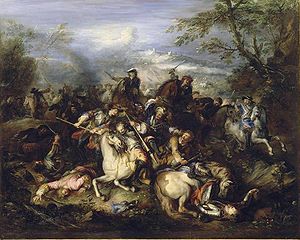 |
||
| “Salle des gardes du roi” Charles Le Brun Charles Le Brun Charles Le Brun , a French painter and art theorist, became the all-powerful, peerless master of 17th-century French art.-Biography:-Early life and training:... |
“The Battle of Leuze, in which the Gardes du corps du roi fought, 18 September 1691” ca. 1691 by Joseph Parrocel Joseph Parrocel Joseph Parrocel was a French Baroque painter, best known for his paintings and drawings of battle scenes.... |
“Salon du grand couvert” Charles Le Brun Charles Le Brun Charles Le Brun , a French painter and art theorist, became the all-powerful, peerless master of 17th-century French art.-Biography:-Early life and training:... |
 |
 |
 |
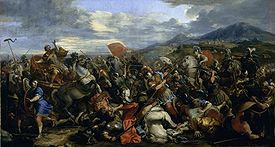 |
 |
 |
| “Calvalrymen quenching their thirst after a battle” ca. 1687 by Joseph Parrocel Joseph Parrocel Joseph Parrocel was a French Baroque painter, best known for his paintings and drawings of battle scenes.... , (1646–1704) South wall |
“Calvalry combat” by Joseph Parrocel Joseph Parrocel Joseph Parrocel was a French Baroque painter, best known for his paintings and drawings of battle scenes.... south wall, west |
“Calvalry charge toward the ramparts of a city” ca. 1687 by Joseph Parrocel Joseph Parrocel Joseph Parrocel was a French Baroque painter, best known for his paintings and drawings of battle scenes.... south wall, east |
“Alexander the Great defeats Darius at the battle of Arabel” ca. 1687 by Joseph Parrocel Joseph Parrocel Joseph Parrocel was a French Baroque painter, best known for his paintings and drawings of battle scenes.... , above the fireplace |
“Calvalryman leading prisoners after the taking of a city” ca. 1687 by Joseph Parrocel Joseph Parrocel Joseph Parrocel was a French Baroque painter, best known for his paintings and drawings of battle scenes.... , north wall |
“Calvalry charge with a fallen rider” ca. 1687 by Joseph Parrocel Joseph Parrocel Joseph Parrocel was a French Baroque painter, best known for his paintings and drawings of battle scenes.... , north wall |
Deuxième antichambre
The deuxième antichambre and the chambre du roi formed part of the apartment of the queen, but in 1684, after the death of Marie-Thérèse d’AutricheMaria Theresa of Spain
Maria Theresa of Austria was the daughter of Philip IV, King of Spain and Elizabeth of France. Maria Theresa was Queen of France as wife of King Louis XIV and mother of the Grand Dauphin, an ancestor of the last four Bourbon kings of France.-Early life:Born as Infanta María Teresa of Spain at the...
, Louis XIV attached this room to his apartment.
The deuxième antichambre served as waiting room for courtiers waiting to attend the king’s lever in the chambre du roi next door. This room was also known as the antichambre des Bassans on account of the number of paintings by the northern Italian artists, Jacopo Bassano
Jacopo Bassano
Jacopo Bassano , known also as Jacopo dal Ponte, was an Italian painter who was born and died in Bassano del Grappa near Venice, from which he adopted the name.- Life :...
, that were displayed on the walls. Over the mantelpiece, the famed “Noli me tangeres” by Lambert Sustris
Lambert Sustris
Lambert Sustris was a Dutch painter active mainly in Venice during the Mannerist style. He is also referred to as Alberto de Olanda . He was born in Amsterdam, and only came to Venice when over 40 years old. His training is unknown, but he was utilized by the studio of Titian for the depiction of...
was displayed. In 1701, the deuxième antichambre and the chambre du roi were combined to form the salon de l’œil de bœuf, which became the main antechamber to the king’s new bedroom.
| “Salon de l’œil de bœuf” Robert de Cotte Robert de Cotte Robert de Cotte was a French architect-administrator, under whose design control of the royal buildings of France from 1699, the earliest notes presaging the Rococo style were introduced. First a pupil of Jules Hardouin-Mansart, he later became his brother-in-law and his collaborator... |
 |
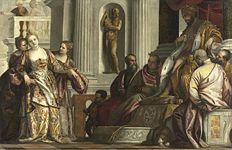 |
| Noli me tangere 2nd half of the 16th century by Lambert Sustris Lambert Sustris Lambert Sustris was a Dutch painter active mainly in Venice during the Mannerist style. He is also referred to as Alberto de Olanda . He was born in Amsterdam, and only came to Venice when over 40 years old. His training is unknown, but he was utilized by the studio of Titian for the depiction of... |
The Fainting of Esther 4th quarter of the 16th century by Paolo Caliari called Veronese Paolo Veronese Paolo Veronese was an Italian painter of the Renaissance in Venice, famous for paintings such as The Wedding at Cana and The Feast in the House of Levi... |
Taking is name from the oval window located in the south cove of the ceiling, the salon de l’œil de bœuf features a gilt-stucco running frieze that decorated the cove of the room’s ceiling and features a trellis-work background on which are groups of dancing putti. It is the decoration of the cove that heralds a transition from the formalistic style that was used in the decoration of the grand appartement du roi
Palace of Versailles
The Palace of Versailles , or simply Versailles, is a royal château in Versailles in the Île-de-France region of France. In French it is the Château de Versailles....
and the Hall of Mirrors
Hall of Mirrors (Palace of Versailles)
The Hall of Mirrors is the central gallery of the Palace of Versailles and is renowned as being one of the most famous rooms in the world.As the principal and most remarkable feature of King Louis XIV of France's third building campaign of the Palace of Versailles , construction of the Hall of...
to a more relaxed style that anticipated the style Louis XV
Louis Quinze
The Louis XV style or Louis Quinze was a French Rococo style in the decorative arts, and, to a lesser degree, architecture.Datable to the personal reign of Louis XV , the style was characterised by supreme craftsmanship and the integration of the arts of cabinetmaking, painting, and...
. Louis XIV spared no expense in decorating this room. Mirrors, “The Fainting of Ester” and “Judith with the head of Holofernes” by Veronese
Paolo Veronese
Paolo Veronese was an Italian painter of the Renaissance in Venice, famous for paintings such as The Wedding at Cana and The Feast in the House of Levi...
hung as pendants, and gilt furniture all contributed to making this one of the most sumptuous rooms in the appartement du roi.
When Louis XIV moved into the chambre du roi in 1684, the following room was designated as the salon du roi or the salon où le roi s’habille. For 17 years, this room served as venue for the ceremonies that surrounded the life of the king, such as the lever and the coucher.
Chambre de Louis XIV
The chambre de Louis XIV was constructed in 1701 on the site of the salon du roi, which dated from the time of Louis XIII. This room underwent a number of modifications during the reign of Louis XIV, most notably in 1678 when the western windows the open onto the terrace were suppressed when the Hall of MirrorsHall of Mirrors (Palace of Versailles)
The Hall of Mirrors is the central gallery of the Palace of Versailles and is renowned as being one of the most famous rooms in the world.As the principal and most remarkable feature of King Louis XIV of France's third building campaign of the Palace of Versailles , construction of the Hall of...
was constructed. When the chambre de Louis XIV was established in 1701, the room became the ideological as well as physical focal point of the palace.
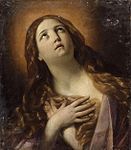 |
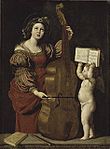 |
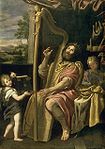 |
| Mary Magdalene Mary Magdalene Mary Magdalene was one of Jesus' most celebrated disciples, and the most important woman disciple in the movement of Jesus. Jesus cleansed her of "seven demons", conventionally interpreted as referring to complex illnesses... ca. 1628-1629 by Guido Reni Guido Reni Guido Reni was an Italian painter of high-Baroque style.-Biography:Born in Bologna into a family of musicians, Guido Reni was the son of Daniele Reni and Ginevra de’ Pozzi. As a child of nine, he was apprenticed under the Bolognese studio of Denis Calvaert. Soon after, he was joined in that... |
Saint Cecilia Saint Cecilia Saint Cecilia is the patroness of musicians and Church music because as she was dying she sang to God. It is also written that as the musicians played at her wedding she "sang in her heart to the Lord". St. Cecilia was an only child. Her feast day is celebrated in the Roman Catholic, Anglican,... ca. 1st quarter of the 17th century by Domenichino Domenico Zampieri Domenico Zampieri was an Italian Baroque painter of the Bolognese School, or Carracci School, of painters.-Life:... |
King David David David was the second king of the united Kingdom of Israel according to the Hebrew Bible and, according to the Gospels of Matthew and Luke, an ancestor of Jesus Christ through both Saint Joseph and Mary... playing the harp ca. 1st quarter of the 17th century by Domenichino Domenico Zampieri Domenico Zampieri was an Italian Baroque painter of the Bolognese School, or Carracci School, of painters.-Life:... |
As a measure of economy, Louis XIV retained much of the decor of the salon du roi in decoration of the chambre de Louis XIV. The over-door paintings included The Portrait of Francisco de Moncada
Francisco de Moncada
Francisco de Moncada , 3rd Marquis of Aytona, was a Spanish diplomat, soldier and writer of the early 17th century...
and a Self-portrait the two by Anthony van Dyck
Anthony van Dyck
Sir Anthony van Dyck was a Flemish Baroque artist who became the leading court painter in England. He is most famous for his portraits of Charles I of England and his family and court, painted with a relaxed elegance that was to be the dominant influence on English portrait-painting for the next...
, Saint John the Baptist
John the Baptist
John the Baptist was an itinerant preacher and a major religious figure mentioned in the Canonical gospels. He is described in the Gospel of Luke as a relative of Jesus, who led a movement of baptism at the Jordan River...
by Caravaggio
Caravaggio
Michelangelo Merisi da Caravaggio was an Italian artist active in Rome, Naples, Malta, and Sicily between 1593 and 1610. His paintings, which combine a realistic observation of the human state, both physical and emotional, with a dramatic use of lighting, had a formative influence on the Baroque...
, and Mary Magdalene
Mary Magdalene
Mary Magdalene was one of Jesus' most celebrated disciples, and the most important woman disciple in the movement of Jesus. Jesus cleansed her of "seven demons", conventionally interpreted as referring to complex illnesses...
by Guido Reni
Guido Reni
Guido Reni was an Italian painter of high-Baroque style.-Biography:Born in Bologna into a family of musicians, Guido Reni was the son of Daniele Reni and Ginevra de’ Pozzi. As a child of nine, he was apprenticed under the Bolognese studio of Denis Calvaert. Soon after, he was joined in that...
. Domenichino’s
Domenico Zampieri
Domenico Zampieri was an Italian Baroque painter of the Bolognese School, or Carracci School, of painters.-Life:...
Saint Cecilia
Saint Cecilia
Saint Cecilia is the patroness of musicians and Church music because as she was dying she sang to God. It is also written that as the musicians played at her wedding she "sang in her heart to the Lord". St. Cecilia was an only child. Her feast day is celebrated in the Roman Catholic, Anglican,...
was placed in the cornice setting of the south wall above the fireplace and the artist’s King David
David
David was the second king of the united Kingdom of Israel according to the Hebrew Bible and, according to the Gospels of Matthew and Luke, an ancestor of Jesus Christ through both Saint Joseph and Mary...
playing the harp hung as pendant opposite on the north wall.
The western wall of the room became the wall of the alcove – the area of the room separated by a balustrade in which the bed was located. The decoration of the alcove, with the ornaments of the agrafe and volutes as well as the trelliswork sculpture, anticipate in many respects anticipates the style Régence
Régence
The Régence is the period in French history between 1715 and 1723, when King Louis XV was a minor and the land was governed by a Regent, Philippe d'Orléans, the nephew of Louis XIV of France....
that was in vogue between 1715-1723. Crowning the bed is Nicolas Coustou’s
Nicolas Coustou
Nicolas Coustou was a French sculptor and academic.Born in Lyon, Coustou was the son of a woodcarver, who gave him his first instruction in art. At eighteen he moved to Paris, to study under C.A...
relief sculpture, France Triumphant, which is complemented by two relief sculptures of Fame by François Lespingola
François Lespingola
François Lespingola was a French sculptor in the team that provided original sculptures, vases and copies after the Antique for the gardens at Versailles....
located in the pendentives of the arch.
| “Chambre de Louis XIV” Robert de Cotte Robert de Cotte Robert de Cotte was a French architect-administrator, under whose design control of the royal buildings of France from 1699, the earliest notes presaging the Rococo style were introduced. First a pupil of Jules Hardouin-Mansart, he later became his brother-in-law and his collaborator... |
The present brocade on the walls of the alcove and for the bed has been rewoven as part of the initiative of the Fifth Republic
French Fifth Republic
The Fifth Republic is the fifth and current republican constitution of France, introduced on 4 October 1958. The Fifth Republic emerged from the collapse of the French Fourth Republic, replacing the prior parliamentary government with a semi-presidential system...
to restore Versailles
Palace of Versailles
The Palace of Versailles , or simply Versailles, is a royal château in Versailles in the Île-de-France region of France. In French it is the Château de Versailles....
. The original alcove and bed hangings were restored in 1736; and, in 1785, Louis XVI ordered the brocade burned from which he obtained over 60 kilograms of gold. The present hanging, while accurate for the period, are not a reproduction of the brocaded that originally hung in the chambre de Louis XIV. Owing to lack of archival information when the project was under taken, it was decided to use the pattern for hangings of the tenture d’hiver for the queen’s bedroom. Only after the project was underway were the original designs found; as the part of the project had been completed, it was decided to use the queen’s tenture d’hiver. On 1 September 1715, Louis XIV died in this room.
Cabinet du conseil
The cabinet de conseil came into being as a council chamber upon the construction of the Salon of WarHall of Mirrors (Palace of Versailles)
The Hall of Mirrors is the central gallery of the Palace of Versailles and is renowned as being one of the most famous rooms in the world.As the principal and most remarkable feature of King Louis XIV of France's third building campaign of the Palace of Versailles , construction of the Hall of...
, which occupied site of the Salon de Jupiter, Louis’s previous council chamber. Initially called cabinet du roi from 1684, with the remodeling of the apartment that occurred in 1701, this room received a new decor that featured walls paneled with mirrors. With the redecoration, the room was rechristened cabinet des glaces. In spite of the luxury of mirrors, this room was furnished in a utilitarian manner. In addition to the velvet covered council table, there were three armchairs and 12 folding stools and a daybed, which Louis XIV used in 1686 as a necessity while suffering from an anal fistula and the surgery that removed it.
Of all the rooms of the appartement du roi, this room perhaps best expressed the personal tastes of Louis XIV. In addition to the collection of gems, there were works by Nicolas Poussin
Nicolas Poussin
Nicolas Poussin was a French painter in the classical style. His work predominantly features clarity, logic, and order, and favors line over color. His work serves as an alternative to the dominant Baroque style of the 17th century...
and Giovanni Lanfranco
Giovanni Lanfranco
Giovanni Lanfranco was an Italian painter of the Baroque period.-Biography:Giovanni Gaspare Lanfranco was born in Parma, the third son of Stefano and Cornelia Lanfranchi, and was placed as a page in the household of Count Orazio Scotti...
on the walls as well as Harpsichord
Harpsichord
A harpsichord is a musical instrument played by means of a keyboard. It produces sound by plucking a string when a key is pressed.In the narrow sense, "harpsichord" designates only the large wing-shaped instruments in which the strings are perpendicular to the keyboard...
with a painted case. The personal nature of this room was offset by the fact that this was the room in which Louis XIV governed France. Councils were held here, writers who extolled the gloire of the Sun King were received here, and private audiences most often occurred in this room.
The last room of the appartement du roi was the cabinet des termes – due to the decor that featured 20 Hermes – also called the cabinet des perruques, as this was the room in which Louis XIV’s wigs were stored. In addition to the gilt Hermes that decorated the wall, the doors were covered with mirrors. The room served as a changing room for the king, where he would change his shirt, wig, and hat as many as four times a day. In the evening, this room would be where Louis XIV would gather with his children, other members of his family, and selected courtiers.
The cabinet des glaces and the cabinet des perruques disappeared in 1755 when Louis XV ordered the enlargement and redecoration of the council chamber. This is the room that is seen today.
In 1748, in order to accommodate the newly constructed cabinet du roi on the 3rd floor, Louis XV had the ceiling of the cabinet de glaces lowered by about a meter. The new dimension to the room necessitated a complete redecoration of the room. The following year, a new fireplace was installed and the one dating from the time of Louis XIV and was sent to Compiègne
Château de Compiègne
The Castle of Compiègne is a French château, a royal residence built for Louis XV and restored by Napoleon. Compiègne was one of three seats of royal government, the others being Versailles and Fontainebleau...
. In 1755, during the installation of a terrace in the cour des cerfs, Louis XV decided to enlarge the council room by incorporating the cabinet des perruques. This larger room was designed by Ange-Jacques Gabriel
Ange-Jacques Gabriel
Ange-Jacques Gabriel was the most prominent French architect of his generation.Born to a Parisian family of architects and initially trained by the royal architect Robert de Cotte and his father , whom he assisted in the creation of the Place Royale at Bordeaux , the younger Gabriel...
with the paneling sculpted by Jules-Antoine Rousseau. The panels were sculpted with symbols appropriate to governance: trophies of peace and war, attributes of the army, navy, justice, and the insignia of the monarchy.
Further reading
- Batiffol, Louis (1913). “Le château de Versailles de Louis XIII et son architecte Philbert le Roy.” Gazette des Beaux-Arts 4 pér., vol. 10 November, 341-371.
- Batiffol, Louis (1909). “Origine du château de Versailles.” La Revue de Paris, April, 841-869.
- Berger, Robert W (1980). “The chronology of the Enveloppe of Versailles.” Architectura 10, 105-133.
- Berger, Robert W (1986). Versailles: The Chateau of Louis XIV. University Park: The College Arts Association.
- Brejon de Lavergnée, Arnauld (1985). “Le cabinet des tableaux du Roi (1661-1685/1686).” Colloque de Versailles.
- Combes, sieur de (1681). Explication historique de ce qu'il y a de plus remarquable dans la maison royale de Versailles. Paris: C. Nego.
- Félibien, André (1694). La description du château de Versailles, de ses peintures, et des autres ouvrags fait pour le roy. Paris: Antoine Vilette.
- Jestaz, Bertrand (1985). “Jules Hardouin-Mansart et ses dessinateurs.” Colloque de Versailles.
- Josephson, Ragnar (1926). “Relation de la visite de Nicodème Tessin à Marly, Versailles, Rueil, et St-Cloud en 1687.” Revue de l'Histoire de Versailles, January–March, 150-67, 274-300.
- Kimball, Fiske (1943). The Creation of the Rococo. Philadelphia: Philadelphia Museum of Art.
- Kimball, Fiske (1949). “Genesis of the Château Neuf at Versailles, 1668-1671.” Gazette des Beaux-Arts 6 pér., vol. 35, 353-372.
- LeGuillou, Jean-Claude (1985). “La création des cabinets et des petits appartements de Louis XV au château de Versailles 1722-1738.” Gazette des Beaux-Arts 6 pér., vol. 105 April 137-146.
- LeGuillou, Jean-Claude (1983). “Le château-neuf ou enveloppe de Versailles: concept et evolution du premier projet.” Gazette des Beaux-Arts 6 pér., vol. 102 December, 193-207.
- LeGuillou, Jean-Claude (1976). “Remarques sur le corps central du château de Versailles.” Gazette des Beaux-Arts 6 pér., vol. 87 February, 49-60.
- LeGuillou, Jean-Claude (1986). “Le Grand et le Petit Appartement de Louis XIV au château de Versailles.” Gazette des Beaux-Arts 6 pér., vol. 108 July–August, 7-22.
- Lighthart, E. (1997). Archétype et symbole dans le style Louis XIV versaillais: réflexions sur l’imago rex et l’imago patriae au début de l’époque moderne. Doctoral thesis.
- Marie, Alfred (1968). Naissance de Versailles. Paris: Edition Vincent, Freal & Cie.
- Marie, Alfred and Jeanne (1972). Mansart à Versailles. Paris: Editions Jacques Freal.
- Marie, Alfred and Jeanne (1976). Versailles au temps de Louis XIV. Paris: Imprimerie Nationale.
- Marie, Alfred and Jeanne (1984). Versailles au temps de Louis XV. Paris: Imprimerie Nationale.
- Meyer, Daniel (1976). “L'appartement interieur du Roi.” Revue du Louvre #3 175-183.
- Monicart, Jean-Baptiste de (1720). Versailles immortailisé. Paris: E. Ganeau.
- Nolhac, Pierre de (1899). “La construction de Versailles de LeVau.” Revue de l'Histoire de Versailles, February, 161-171.
- Nolhac, Pierre de (1901). La création de Versailles. Versailles: L. Bernard.
- Nolhac, Pierre de (1925). Versailles, résidence de Louis XIV. Paris: L. Conrad.
- Nolhac, Pierre de (1926). Versailles au XVIIIe siècle. Paris: Louis Conard.
- Saule, Béatrix (1985). “Trois aspects du premier ameublement du château de Versailles sous Louis XIV.” Colloque de Versailles.

